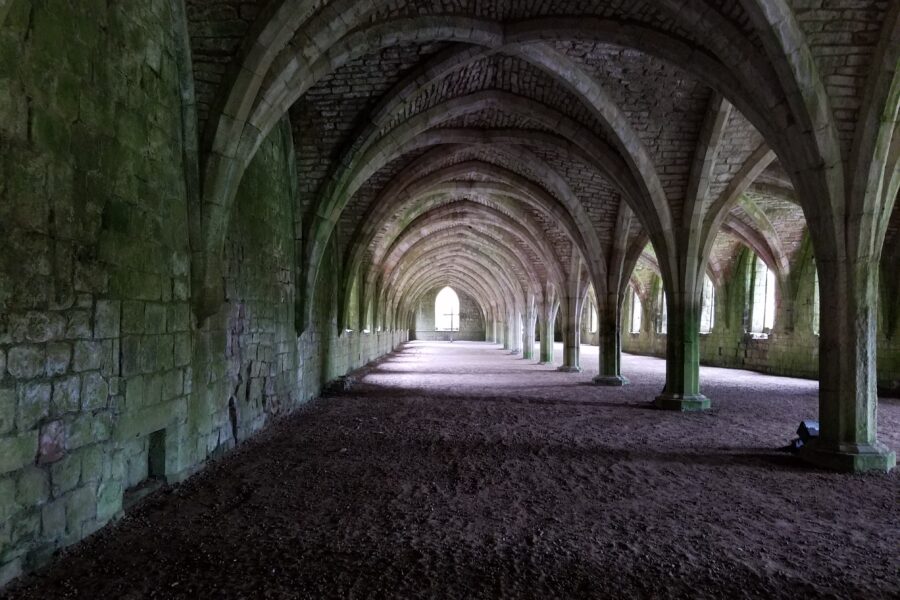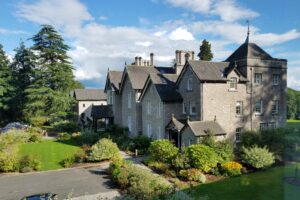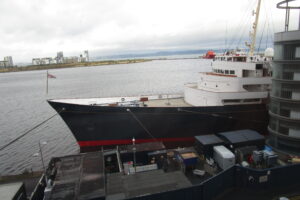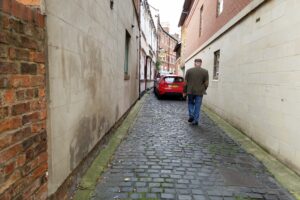
Working our way out of the traffic jam that is York because of the construction on Micklegate, we head west toward Fountains Abbey. We drive on familiar roads till Jeeves takes us down the A1(M) dual carriageway. By this time it really is raining, however we make good time till we reach our exit and find it closed. Following diversion signs, we continuing on the A1. Jeeves goes crazy. He goes crazier still when we follow the diversion exit and continue heading west. We are happy with our progress till, in the middle of nowhere, the diversion sign reads End of Diversion. Michael continues following his nose. Jeeves is not happy.

When I see a sign for Hawes—which I know is somewhere in the middle of the Yorkshire Dales—I decide to check Google Maps for the big picture. I then suggest we turn left at the next opportunity. Finally Jeeves sees a light at the end of the tunnel and stops telling us to “turn around when possible”. He leads us down a deserted sheep path—or at least a path that is really only wide enough for sheep. I am quite happy with our new route. I am the only one in the car that is happy. But Michael is at least content that Jeeves is speaking to us again.
Reaching the visitors center for Fountains Abbey, Michael shows them our membership card for the National Trust and we take the long cliff path trail toward the unknown. Finally we see the ruins of the great Abbey peaking between the trees in the valley below. So of course we walk past them toward Fountains Hall the manor house built between 1598 and 1604 using stones from the Abbey ruins. Still used as a residence today, only a few ground floor rooms are open to the public.

The Duke and Duchess of Windsor stayed here—Elizabeth II’s mom and dad—the future King George VI and the Queen Mother. The castle like main room is an empty cavern. It certainly isn’t cozy. The ceiling soars. Walking through a doorway Michael ignores, I find the adjacent room is furnished in tattered genteel, softening the mood. The leaded glass windows are wonderful.

We work our way through the centuries old formal gardens toward the old mill used by the monks to grind the wheat that made their daily ration of bread. Walking through an apple orchard where the too damp ground is burdened with decaying apples, I stop to take pictures. Michael shakes his head.



But the thing we are here for, the thing that has lured everyone down into this valley are the dramatic ruins of Fountains Abbey, the largest monastic ruins in England. It is time for the entrée. The ruins are certainly impressive. They are massive. In scope. In structure. Nothing like the delicate ethereal beauty of the bones of Rievaulx, these ruins are towering sturdy columns. Staunch. Soldier like. Seemingly indestructible. The strains of Carmina Burana run through my head. The first movement of Beethoven’s 5th. I wish I could actually hear the music—either would do.



The abbey was founded in 1132 by thirteen Benedictine monks seeking to live a devout and simple lifestyle—from what I see, I think they failed the simple part. When they became a part of the Cistercian Order with their system of lay brothers, the abbey became wealthy. Wool production, lead mining, cattle rearing, horse breeding and stone quarrying all contributed to the Abbey’s treasury.

I am past being appalled; past being angry. After learning that there were over 800 abbeys destroyed by Henry VIII I am inured to the reality of it all. Eight hundred. Unbelievable. At the time Henry started his dissolution of the abbeys, he was running through his inheritance like mad. The combined wealth of the abbeys were possibly richer than the King. I keep telling Michael, every time we see a ruin, “He just used Ann Boleyn as an excuse.” It seems so logical. I believe it. I wonder why no else does?
I have learned during my Google searches, when my curiosity was peaked after seeing Whitby Abbey and Rievaulx, that once Henry decided to dissolve the abbeys his government moved with speed. The religious institutions valuables—gold, silver, bronze and lead – were taken by the government and melted down. The land was swiftly rented out. Other items were auctioned off. What the King did not want was taken by the local population—bricks, stone, wood. Whatever they could loot or salvage. It is easy to see why abbeys became ruins rather than just deserted buildings.
Surviving bad harvests, raids from the Scots, and the Black Death, Fountains Abbey couldn’t survive Henry VIII. The ruins are extensive both above and below ground. This may take forever. As I wander slowly through the forest of columns and crumbling stone, for the first time I notice the actual construction of the thick walled sanctuary. It is rubble piled in the middle of cut stone.
“How did they do this?” I ask Michael. “Did they just stack a mass of ill shaped stone and then put the good stuff around it?” He thinks they built the walls then poured in the rubble. I’ll have to look that up when I have computer access. One more thing to check on. If only I could retain the masses of information I have uncovered and discovered on this trip.
Reading that the Abbey ruins were purchased when they became available as part of a large scheme used to complete the Studley Royale Water Gardens does not surprise me—not after Rievaulx. The objective was to create a stunning climax for visitors to the estate, giving them the ultimate vista at the summit of the garden. A rich man’s sanctuary, dressed to impress. We turn our tired little feet away from the Abbey and toward the gardens. Every day I understand more and more why the word massive is ubiquitous in the English vernacular. This entire estate is massive.

We walk and walk and walk. Following the trail we climb a hill for naught, reading what was here and what might be here in the future. As we make our way back down the hill, I am sorely tempted to tell those who are trekking upward not to bother. There is nothing there, not even a spectacular view.

We find the bridge that will take us to the other side of the river and the area where William Aislabie created his follies that surround and dot the landscape of his inherited estate. We stop at the Temple of Piety, resting and watching. The swans. The water. The kids out for a day’s adventure with their parents. We laugh when we here one little boy tell another, “Don’t go up there, you’ll ruin the day.”


We know the trail from here goes up, and we think about it. We think about it for a long time. My curiosity wins out. I want to see the serpentine tunnel—never mind the faux temples. We agree to walk till we get to the Octagon Tower and then turn back. The distance doesn’t look that long—but it is steeeeep. By the time we get to the top I am ready to rest again. The only thing I see is a small dark hole in front of me.

It is dark in here. Totally dark. And curvy. And still uphill. My camera sees better than my eyes. I only hope there are no holes in the road.


Exiting the tunnel, we see that the Octagon Tower is just around a stand of trees to our right. The path from there looks flat, but I don’t trust the hilly landscape. We have been walking and looking for three hours and we still have to walk back. Regrettably Anne Boleyn’s Seat, the High Ride path, and the Temple of Fame will have to go unseen.
We return to the dark winding tunnel.

The Dissolution of the Monasteries
Division between the monasteries was that some were open while some were closed. Closed religious were closed to all outsiders. Open houses meant that the occupants worked with the local community, helping the sick and educating the young boys. It was common for them to be poor as what money they raised was spent on others. However, closed orders could be very wealthy. They relied on the local population to work for them for free. Some grew spectacularly rich. They presumably owned about one-third of all the land in England and Wales. The thirty richest monasteries were as rich or richer than the wealthiest nobles in Great Britain. Acquired over the centuries, their wealth came from people who hoped to buy their way into Heaven by bequeathing their land to the monasteries. I don’t think anyone from the monasteries bothered to tell them that it probably wouldn’t work.
How to Build a Castle
“Walls were generally built of stone within wooden frames designed to hold the stone in place while the mortar dried. For thick walls, the wall was usually constructed with a cavity that was filled with rubble rather than being solid stone.” en.wikibooks.org







































Leave a Reply
Your email is safe with us.